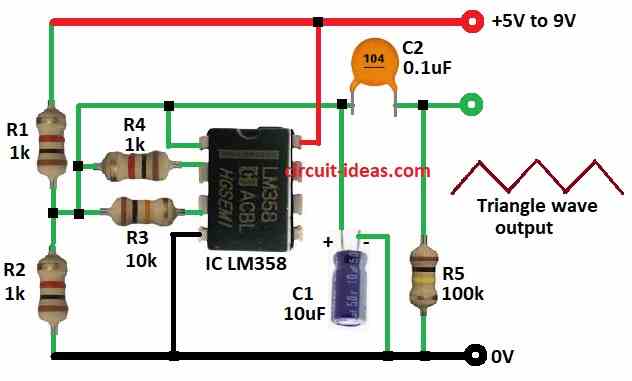In this this article we will learn how the triangle wave goes up, down, then up again and then repeats the same.
It is special wave made from small waves called harmonics.
It shape look like triangle because small waves match like bricks.
Harmonics in triangle wave get weak fast and is not strong like square wave.
So triangle wave is more smooth and is not sharp like square wave.
Triangle wave used in many things like signal work, making waveforms and testing tools.
This article for Simple Triangle Wave Generator Circuit using IC LM358 show how to make triangle waves with few parts like IC, resistors and capacitors.
This circuit works with 5V to 9V power.
Circuit Working:

Parts list:
| Component Type | Value | Quantity |
|---|---|---|
| Resistors | 1k 1/4 watt | 3 |
| 10k 1/4 watt | 1 | |
| 100k 1/4 watt | 1 | |
| Capacitors | Electrolytic 10µF 25V | 1 |
| Ceramic 0.1µF | 1 | |
| Semiconductors | IC LM358 | 1 |
Main part in circuit is op-amp.
It work like integrator and Schmitt trigger.
Op-amp from LM358 with resistors R1, R2, R3 make Schmitt trigger.
This makes steady square wave by switching when input go over set voltage.
R3 give feedback and help op-amp switch clean between high and low and make good square wave.
Op-amp also work as integrator using R4 1k and C1 10µF on inverting input.
It take square wave from pin 1 and changes it to triangle wave by integrating.
So output voltage goes up and down again and again and this make triangle wave.
Formulas:
These formulas show how triangle wave circuit with LM358 op-amp works:
1. Schmitt Trigger Formulas:
Positive Threshold (Vth+):
Vth+ = Vref + (R2 / (R1 + R2)) × Vcc
Negative Threshold (Vth−):
Vth− = Vref − (R2 / (R1 + R2)) × Vcc
Vref is set by voltage divider.
2. Hysteresis (ΔV):
ΔV = Vth+ − Vth−
3. Integrator Formulas
Frequency (f):
f = 1 / T = 1 / (2RC)
Period (T):
T = 2RC
where,
- R is R4 and C is C1.
4. Slope of Triangle Wave:
Slope = (Vmax − Vmin) / (T / 2)
where,
- Vmax and Vmin are top and bottom of wave.
5. Integrator Output Voltage:
Vout(t) = ∫Vin(t)dt
This means voltage goes up and down to make triangle shape.
These formulas help understand and check how triangle wave circuit works with LM358.
How to Build:
To build a Simple Triangle Wave Generator Circuit using IC LM358 follow the below mentioned steps for connections:
- Put all parts as per circuit diagram.
- Connect pin 1 of LM358 to triangle wave output using capacitor C2.
- Connect pin 2 to pin 1 using resistor R4.
- Connect pin 3 to pin 1 using resistor R3.
- Connect pin 4 to GND.
- Connect pin 8 to positive supply.
- Connect resistor R1 and R2 between positive supply and GND.
- Pin 3 goes to point between R1 and R2.
- Connect capacitor C1 between pin 1 and GND.
- Connect resistor R5 from output of C2 to GND.
Conclusion:
Simple Triangle Wave Generator Circuit using IC LM358 is simple and easy to build.
Change resistor and capacitor values to adjust wave frequency and size.
It is good for electronics testing and making projects.
References:
Building a triangle wave generator using two LM358 with single supply operation
Leave a Reply